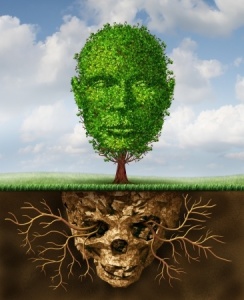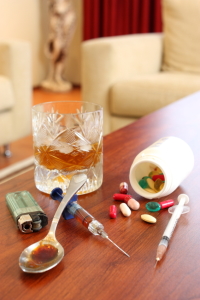Stinkin’ Thinkin’ Addiction
“Most Substance-addicted people are also addicted to thinking, meaning they have a compulsive and unhealthy relationship with their own thinking.” (David Foster Wallace, Infinite Jest)
Once a person becomes dependent upon a drug there is a tendency to transfer that addiction to other mood-altering substances. This is what is meant by cross addiction. If an individual becomes addicted to one drug, they can rapidly develop an addiction to another drug in that class of drugs. The reason is mostly physical. The body becomes accustomed to the effects of one kind of drug and will have an affinity to drugs that are similar. “Cross addiction occurs because all addictions work in the same part of the brain.” For an in-depth examination of the neurobiological factors underlying drug addiction and relapse, read “Neuroplasticity in Drug Addiction” on “Terry Gorski’s Blog.”
A chemically dependent person who comes to rely on a particular drug may, for various reasons, decide to abstain from that drug. If they substitute something else, it may not be as effective as the original drug of choice was for them. This can lead to thinking about or craving the original drug. Intoxication with the substitute drug that results in impaired thinking could lead them to use their primary drug again. You don’t have to be incredibly intoxicated either. You just have to be high enough to want your drug of choice and be willing to act on the impulse.
Alisha celebrated a years worth of clean time since she stopped using cocaine. She went out to dinner with a guy on a first date. He must have wanted to impress her, because he’d taken her to a very nice restaurant. He didn’t know about her history and ordered a bottle of wine. Alisha didn’t see the harm in having a glass or two of wine; alcohol had never been her thing. In the middle of the dinner she excused herself and called her cocaine dealer from the bathroom.
In The Science of Addiction, Carleton Erickson said that cross-dependence or cross-tolerance occurs between drugs within the same class. So when a person becomes dependent upon one benzodiazepine, they are dependent upon other benzodiazepines. “It is also possible for a person to be cross-tolerant to drugs of different classes.” One example could be benzodiazepines and alcohol.
Cross-dependence between classes occurs as well. “Reports suggest that such cross-dependence occurs between alcohol and cocaine, alcohol and nicotine, alcohol and benzodiazepines, and heroin and cocaine.” Terence Gorski suggested that this cross-dependency is likely to develop gradually. Early in my professional career I referred a heroin addict to an inpatient detox and rehab program, expecting that the individual would be referred back once the inpatient treatment was completed. In their infinite wisdom, the treatment staff referred the man to a methadone clinic. Two or three years later, he came back to my outpatient program, but not for heroin. He never resumed using heroin. Now he had a serious alcohol problem. What started out as a few drinks to take the edge off became a full-blown alcohol dependency problem.
Substance use disorders cannot be effectively treated as if each one is a discrete disease entity. Stable, long term sobriety is only possible if the person lays a foundation of abstinence from all addictive drugs and then works through the personal and social dysfunction that inhabited their life concurrently with their substance use. Sobriety is not simply whether or not you are drinking or using drugs. A relapse begins sometime before the individual resumes active drinking or drug use. Terence Gorski has said:
Sobriety is abstinence from addictive drugs plus abstinence from compulsive behaviors plus improvements in bio-psycho-social health. Sobriety includes all three things. To the extent that you have accomplished those three things you are sober; to the extent that you have not accomplished those three things you are not sober.
The grey area between initial abstinence and sobriety is where cross-addictions develop. These substitutes can be other chemicals or compulsive behaviors—what Gorski referred to as “process addictions.” These compulsive behaviors/process addictions will typically fall into eight types: 1) eating/dieting; 2) gambling; 3) working/achieving; 4) exercising; 5) sex; 6) thrill seeking; 7) escape; 8) spending.
Compulsive behaviors are actions that can produce excitement or emotional release, what Gorski called an addictive brain response. “This means that the brain is flooded with pleasure chemicals that create a unique sense of euphoria while being inhibiting from producing warning chemicals which cause the feelings of stress, anxiety, fear, and panic.” So these triggers initiate a neurochemical reaction that reinforces the person to keep pulling the addictive trigger.
Evidence supportive of this view is found in the treatment of pathological gambling with the opiate antagonist, naltrexone (here). Piz et al. published a case report where a patient with a compulsive gambling problem avoided a resumption of gambling for three years while taking naltrexone.
Many people begin with a chemical addiction and in sobriety “crossover” or “migrate” into a process addiction. In his book, Staying Sober, Terence Gorski noted how the same behaviors could be compulsive, process addictions or positive outlets. “Every behavior that can be used compulsively, can be productive if used in a way that does not result in long-term pain or dysfunction.” A behavior that is used compulsively is used as some people use drugs—to alter mood, turn off mind and evade reality. Behaviors are positive outlets when they enhance reality and help a person to cope more effectively with reality.
I have read and used Terence Gorski’s material on relapse and recovery for most of my career as an addictions counselor. I’ve read several of his books and booklets; and I’ve completed many of his online training courses. He has a blog, Terry Gorski’s blog, where he graciously shares much of what he has learned, researched and written over the years. This is one of a series of articles based upon the material available on his blog and website.



